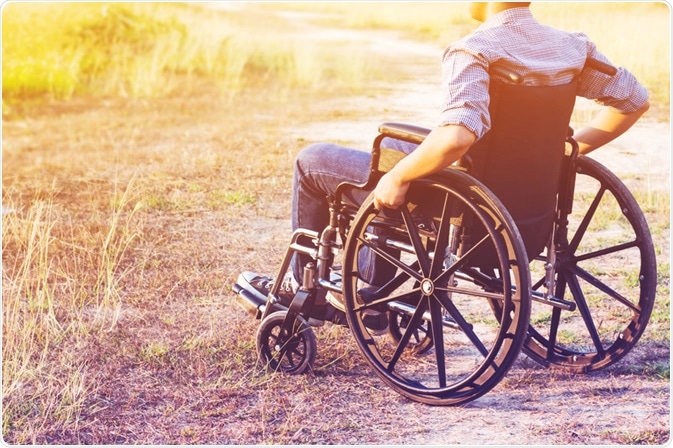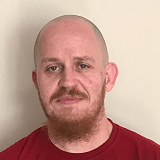Muscular dystrophy is a debilitating muscle disorder that causes a gradual weakening of the muscles in sufferers worldwide. Alleviating the adverse effects of the disorder are of concern to researchers and health professionals worldwide.

Image Credit: Freedom Studio/Shutterstock.com
What is muscular dystrophy?
Muscular dystrophy affects approximately 1 in 3,500 male births. Though rare in females, there are documented cases. It is usually diagnosed between 3 and 6 years of age and is degenerative, causing weakness in the proximal muscles of the legs and pelvic area, leading to atrophy.
As the disease progresses in patients, the muscles of the trunk, forearms, and other areas are affected.
A spectrum of muscular dystrophies exists, which range in severity. Each has specific characterizations of abnormalities, and they are all caused by alterations in the genes that code for dystrophin, an essential protein for healthy muscle growth and integrity. Abnormalities include muscle fiber necrosis, variation in the size of muscle fibers, and inflammation.
At the most severe end of the spectrum is Duchenne muscular dystrophy, which is characterized by a complete lack of dystrophin protein. A less severe form of muscular dystrophy is known as Becker muscular dystrophy, in which there is decreased or truncated dystrophin.
The genetic basis of the condition
The muscular dystrophies are caused by alterations to X-linked genes (specifically, the DMD gene on the short arm), which is why the majority of cases are male. Most females are carriers of the disease and are asymptomatic as they will inherit 2 X chromosomes, only one of which carries the defective gene.
A male with the disorder, if able to reproduce, will pass the gene to all their daughters, who will become carriers. Female carriers have a 25% chance of having a carrier or non-carrier daughter, or a healthy or affected son.
Not all cases of muscular dystrophy are inherited, however. For an unknown reason, some instances can arise sporadically due to mutations.
Signs & symptoms of muscular dystrophies
Muscular dystrophy progresses at similar rates across all patients. However, individual variation can occur, with different signs and symptoms occurring at different stages of development.
Early symptoms and signs in children can include delays in reaching developmental milestones, for example sitting or standing without assistance, an unusual, waddling gait, and Gowers’ sign, where a patient has to use their hands and arms to raise from a sitting or squatting position due to a lack of thigh and hip muscle strength.
Toddlers and young children can also display pseudohypertrophy (abnormally enlarged calves due to muscle scarring) and may be awkward or clumsy. Symptoms may seem to improve between the ages of 3 and 5; however, this may be due to normal growth and development.
Progression and development
With the progression of the condition, scoliosis or lordosis can develop in patients, leading to an abnormal curvature of the spine. Contractures, when thickening and shortening of tissues cause restricted movement, and abnormal fixation, especially around the joints, are also commonly developed in sufferers.

Image Credit: Albina Glisic/Shutterstock.com
In extreme cases, muscles in the gut, heart, and respiratory systems can be affected. Without physical therapy, leg braces are usually needed by age 8 or 9 in most patients, and they are wheelchair-bound by their teenage years.
Complications that affect the lungs and heart can lead to heart attacks and respiratory failure. Those affecting the gut muscles can lead to constipation and diarrhea.
There is no known cure for muscular dystrophy; however, treatments and therapies exist that can have a varying degree of success, and researchers are investigating ways to improve them and find new ones.
Treating and alleviating the effects of muscular dystrophies
Therapies including low-impact exercise, physiotherapy, and occupational therapy can help alleviate mobility and breathing problems. Once breathing problems become too severe, however, machines need to be utilized to help regulate breathing and coughing, which is especially important during sleep.
It is also useful to note that MD can cause emotional as well as physical suffering, and for this reason many support groups exist.
Swallowing problems that can lead to dysphagia increase the risk of choking and chest infections if food and liquid enter the lungs. Methods to alleviate these problems can include help from dieticians and speech and language therapists. Surgery can also be utilized, including expanding the esophagus by inflating a small balloon into it.
Heart complications can be treated by monitoring the condition, and in some cases, medication such as beta-blockers (which control irregular heartbeats) or ACE inhibitors (which relax the arteries) can be prescribed to patients. Pacemakers can also be employed to regulate heartbeat.
Several medications have been shown to alleviate the effects of MD. In cases of Duchenne MD, corticosteroid medication can improve muscle strength and function for long periods of time, whilst slowing down degenerative muscle wasting.
However, there are side-effects such as weight gain and elevated hair growth. Creatine supplements have recently been found to help improve muscle strength in some patients.
More recent developments
Ataluren is a recently developed medication that can be used to treat MD. It works by making the cell “ignore” a premature stop signal which causes dystrophin production to cease prematurely. This is caused by a nonsense mutation that affects around 13 percent of sufferers. It is essentially a “protein restoration therapy” and facilitates the production of dystrophin in sufferers.
Recent trials into new and novel therapies based upon gene therapy are another promising route to the treatment of MD. One of the potential treatments is “exon skipping”, which effectively skips exons (sections of DNA containing information for proteins) that are missing or duplicated in some sufferers.
This could lead to more dystrophin being produced as it would be coded for normally, therefore alleviating the effects of MD. Another potential treatment being researched is stem cell therapy. Trials are ongoing into this therapy to see if it can be used to regenerate damaged muscle tissue.
In conclusion
Muscular dystrophies are a debilitating set of conditions that cause suffering and several health complications, with no current cure for them.
Current and future therapies in development give some hope to sufferers across the world and are a particular focus for researchers in the field of medical research.
Sources
- Duchenne Muscular Dystrophy – Rare Disease Database https://rarediseases.org/rare-diseases/duchenne-muscular-dystrophy/
- Treatment: Muscular Dystrophy – NHS https://www.nhs.uk/conditions/muscular-dystrophy/treatment/
- What is exon skipping and how does it work? – Muscular Dystrophy UK www.musculardystrophyuk.org/…/
- Sun C et al. (2020) Stem cell-based therapies for Duchenne muscular dystrophy Exp Neurol Vol. 323 Article 113086 https://www.ncbi.nlm.nih.gov/pubmed/31639376
Further Reading
- All Muscular Dystrophy Content
- What is Muscular Dystrophy?
- Muscular Dystrophy Types
- Muscular Dystrophy Causes
- Muscular Dystrophy Symptoms
Last Updated: May 14, 2020

Written by
Reginald Davey
Reg Davey is a freelance copywriter and editor based in Nottingham in the United Kingdom. Writing for News Medical represents the coming together of various interests and fields he has been interested and involved in over the years, including Microbiology, Biomedical Sciences, and Environmental Science.
Source: Read Full Article
